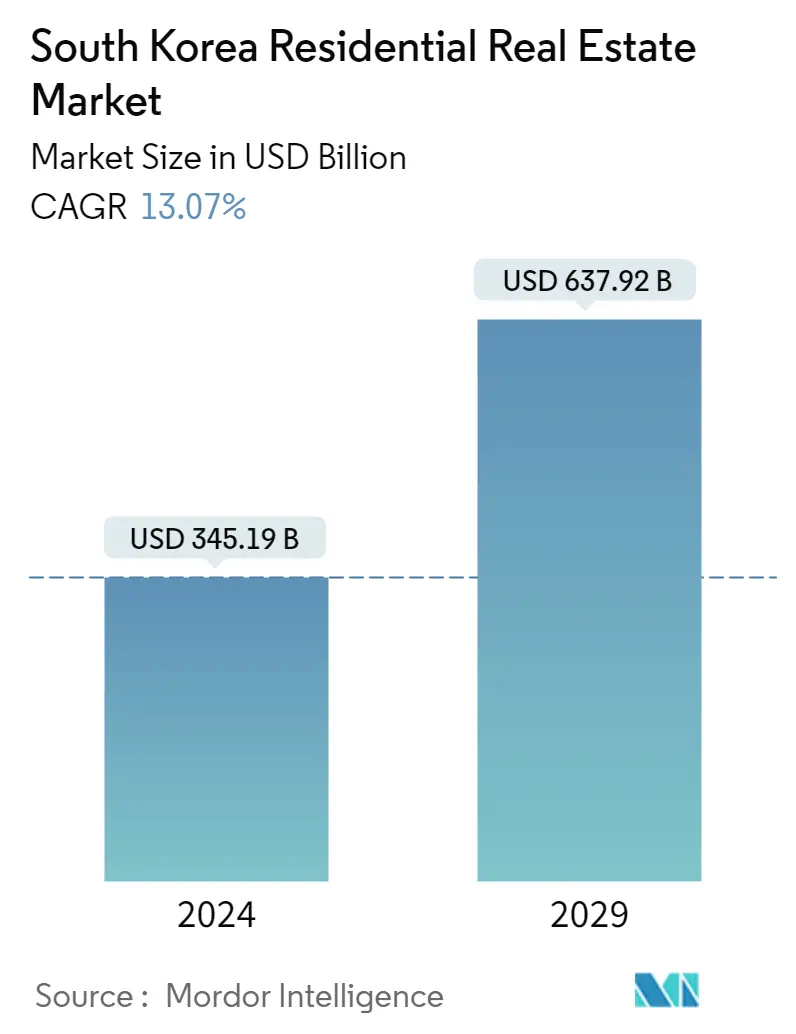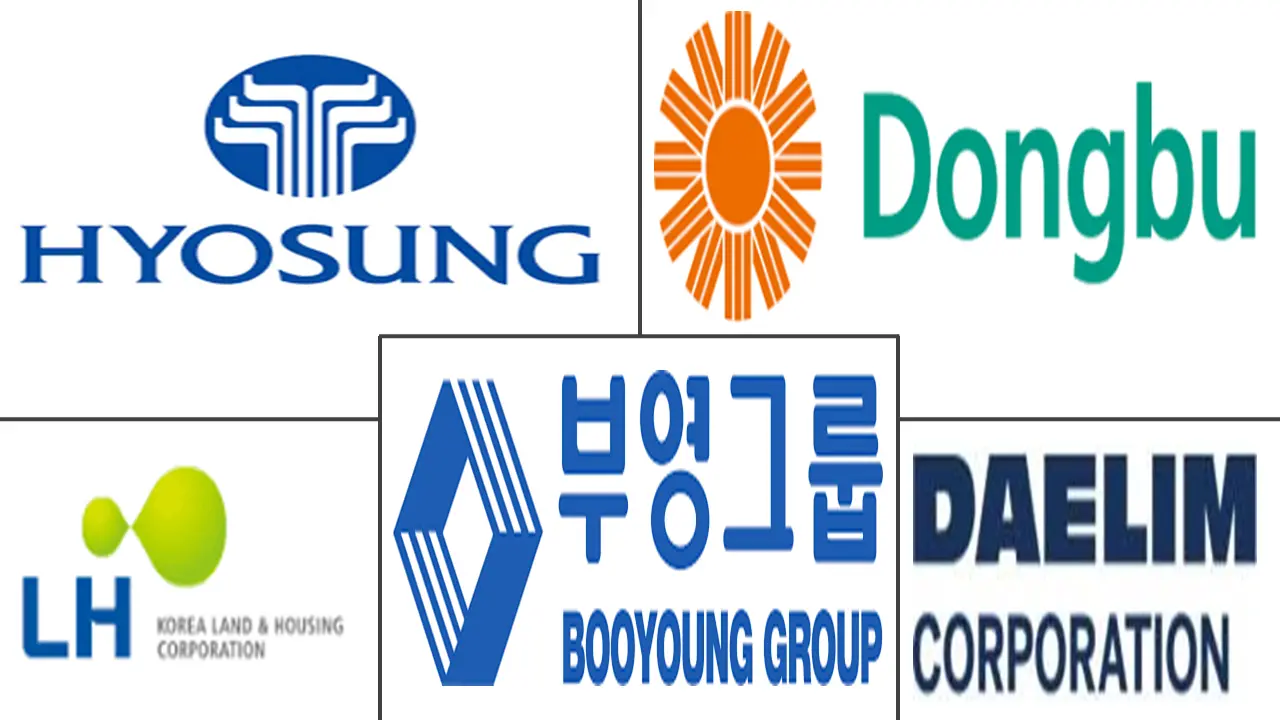Market Size of South Korea Residential Real Estate Industry

| Study Period | 2020 - 2029 |
| Base Year For Estimation | 2023 |
| Market Size (2024) | USD 345.19 Billion |
| Market Size (2029) | USD 637.92 Billion |
| CAGR (2024 - 2029) | 13.07 % |
| Market Concentration | Low |
Major Players
*Disclaimer: Major Players sorted in no particular order |
South Korea Residential Real Estate Market Analysis
The South Korea Residential Real Estate Market size is estimated at USD 345.19 billion in 2024, and is expected to reach USD 637.92 billion by 2029, growing at a CAGR of 13.07% during the forecast period (2024-2029).
The increasing housing demand drives the market. Furthermore, the market is driven by the increasing construction of apartments in the country due to land scarcity.
- The COVID-19 pandemic brought a huge difference in the residential real estate market in South Korea. The number of private apartments sold in Seoul from January 2021 to July 2021 was 1,895 units, a decrease of 86% from the same period last year (13,782 units), while in the metropolitan area, 40,876 households were sold during the same period.
- In January 2021, South Korea's finance ministry prioritized increasing housing supply, with construction regulations in heavily crowded urban areas relaxed and redevelopment projects supported to stabilize and drive the housing market. Further, the government announced its plan to develop 830,000 housing units nationwide, including 320,000 units in Seoul, in two years. In Asia, South Korea has developed its green building certification system, the Green Standard for Energy and Environmental Design (G-SEED), which assesses the eco-friendliness of buildings by evaluating eight environmental areas.
- High-rise apartments, detached homes, and row houses are Korea's primary housing types. In South Korea, apartments are the most prevalent type of housing. These flats are frequently located in residential high-rise structures with five to twenty levels. The most popular form of housing for South Koreans is an apartment since the neighbourhood is readily constructed around the apartment complex. An apartment complex often houses hundreds to thousands of households with retail stores, recreation areas, and childcare facilities. Nevertheless, detached homes are becoming more popular as it has become more fashionable to live outside cities.
South Korea Residential Real Estate Industry Segmentation
Residential real estate includes both new construction and resale homes. Residential real estate is an area developed for people to live in and cannot be used for commercial or industrial purposes. A complete background analysis of the South Korea Residential Real Estate Market, including the assessment of the economy and contribution of sectors in the economy, a market overview, market size estimation for key segments, emerging trends in the market segments, market dynamics, and geographical trends, and COVID-19 impact, is covered in the report.
The South Korean residential real estate market is segmented by type (apartments, condominiums, landed houses, and villas) and geography (Seoul and Other Locations). The report offers market sizes and forecasts in value (USD) for all the above segments.
| By Type | |
| Apartments and Condominiums | |
| Landed Houses and Villas |
| By Geography | |
| Seoul | |
| Other Locations |
South Korea Residential Real Estate Market Size Summary
The South Korea residential real estate market is poised for significant growth, driven by increasing housing demand and the construction of apartments due to land scarcity. The market is characterized by a predominance of high-rise apartments, which are the most common housing type, offering integrated communities with retail and recreational facilities. The government's proactive measures, such as relaxing construction regulations and supporting redevelopment projects, aim to stabilize and expand the housing supply, particularly in urban areas like Seoul. The introduction of the Green Standard for Energy and Environmental Design (G-SEED) reflects the country's commitment to sustainable building practices, addressing both environmental concerns and the need for more housing units.
Rapid urbanization and demographic shifts in South Korea are contributing to rising property prices and a shortage of affordable housing, posing challenges to financial stability and quality of life. The government's ambitious plan to supply hundreds of thousands of housing units in major cities is a response to these challenges, with a focus on creating diverse housing options to cater to various income levels. The market is fragmented, with numerous regional players and a few global companies, and is largely dominated by public sector initiatives. Recent developments, such as the Parkside Seoul project and GS E&C's modular housing division, highlight the ongoing innovation and investment in the sector, aiming to enhance urban living experiences and streamline construction processes.
South Korea Residential Real Estate Market Market Size - Table of Contents
-
1. MARKET INSIGHTS
-
1.1 Market Overview (Current Scenario of South Korea’s Economy and the Residential Real Estate Market)
-
1.2 Insights into the Interest Rate Regime for General Economy and Real Estate Lending
-
1.3 Demographic Analysis of South Korea
-
1.4 Data and Commentary on Key Residential Real Estate Parameters
-
1.5 Insights into Real Estate Purchasers
-
1.6 Spotlight on Real Estate Contract Types
-
1.7 Spotlight on the Trends in the South Korean Residential Real Estate Market
-
1.8 Insights into the Primary and Secondary Markets in South Korea
-
1.9 Spotlight on Affordable Housing Supply in South Korea
-
1.10 Technological Innovations in South Korea’s Residential Real Estate Market
-
1.11 Insights into Environment Friendliness in the South Korea Construction Market
-
1.12 Government Policies and Initiatives
-
1.13 Insights into Rental Yields and Prices in the Real Estate Segment
-
1.14 Insights into Unit Based Metrics
-
1.15 Insights into Return Metrics for Transactions of the Residential Real Estate Market in South Korea
-
1.16 Impact of the COVID-19 on the Market
-
-
2. MARKET SEGMENTATION
-
2.1 By Type
-
2.1.1 Apartments and Condominiums
-
2.1.2 Landed Houses and Villas
-
-
2.2 By Geography
-
2.2.1 Seoul
-
2.2.2 Other Locations
-
-
South Korea Residential Real Estate Market Market Size FAQs
How big is the South Korea Residential Real Estate Market?
The South Korea Residential Real Estate Market size is expected to reach USD 345.19 billion in 2024 and grow at a CAGR of 13.07% to reach USD 637.92 billion by 2029.
What is the current South Korea Residential Real Estate Market size?
In 2024, the South Korea Residential Real Estate Market size is expected to reach USD 345.19 billion.

